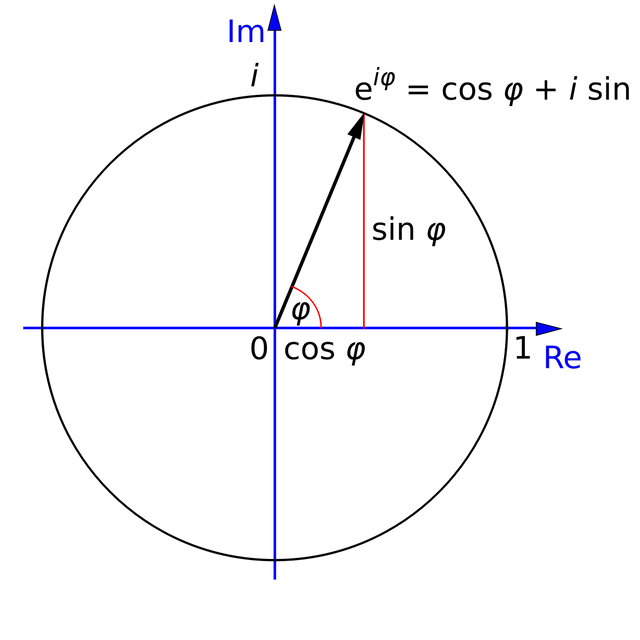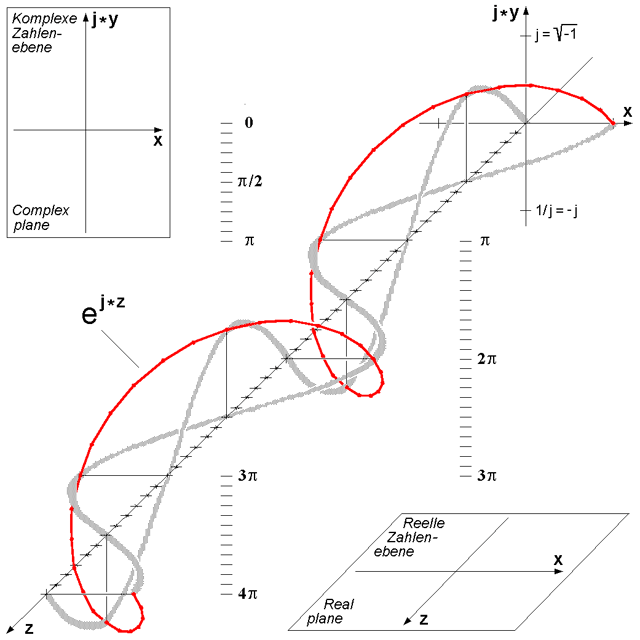Euler's formula

Euler's formula

Euler's formula, named after Leonhard Euler, is a mathematical formula in complex analysis that establishes the fundamental relationship between the trigonometric functions and the complex exponential function. Euler's formula states that for any real number x:

where e is the base of the natural logarithm, i is the imaginary unit, and cos and sin are the trigonometric functions cosine and sine respectively, with the argument x given in radians. This complex exponential function is sometimes denoted cis x ("cosine plus i sine"). The formula is still valid if x is a complex number, and so some authors refer to the more general complex version as Euler's formula.[1]
Euler's formula is ubiquitous in mathematics, physics, and engineering. The physicist Richard Feynman called the equation "our jewel" and "the most remarkable formula in mathematics".[2]
 , Euler's formula evaluates to
, Euler's formula evaluates to , which is known asEuler's identity.
, which is known asEuler's identity.History
Johann Bernoulli noted that[3]

And since

the above equation tells us something about complex logarithms by relating natural logarithms to imaginary (complex) numbers. Bernoulli, however, did not evaluate the integral.
Bernoulli's correspondence with Euler (who also knew the above equation) shows that Bernoulli did not fully understand complex logarithms. Euler also suggested that the complex logarithms can have infinitely many values.
Meanwhile, Roger Cotes in 1714 discovered that[4]

Cotes missed the fact that a complex logarithm can have infinitely many values, differing by multiples of 2iπ, due to the periodicity of the trigonometric functions.
The view of complex numbers as points in the complex plane was described about 50 years later by Caspar Wessel.
Applications in complex number theory

Three-dimensional visualization of Euler's formula. See also circular polarization.
- Interpretation of the formula
This formula can be interpreted as saying that the function eiφ is a unit complex number, i.e., it traces out the unit circle in the complex plane as φ ranges through the real numbers. Here φ is the angle that a line connecting the origin with a point on the unit circle makes with the positive real axis, measured counterclockwise and in radians.
The original proof is based on the Taylor series expansions of the exponential function ez (where z is a complex number) and of sin x and cos x for real numbers x (see below). In fact, the same proof shows that Euler's formula is even valid for all complex numbers x.
A point in the complex plane can be represented by a complex number written in cartesian coordinates. Euler's formula provides a means of conversion between cartesian coordinates and polar coordinates. The polar form simplifies the mathematics when used in multiplication or powers of complex numbers. Any complex number z = x + iy, and its complex conjugate, z = x − iy, can be written as

where
φ is the argument of z, i.e., the angle between the x axis and the vector z measured counterclockwise in radians, which is defined up to addition of 2π. Many texts write φ = tan−1 y/x instead of φ = atan2(y,x), but the first equation needs adjustment when x ≤ 0. This is because for any real x and y not both zero the angles of the vectors (x, y) and (−x, −y) differ by π radians, but have the identical value of tan φ = y/x.
- Use of the formula to define the logarithm of complex numbers
Now, taking this derived formula, we can use Euler's formula to define the logarithm of a complex number. To do this, we also use the definition of the logarithm (as the inverse operator of exponentiation):

and that

both valid for any complex numbers a and b.
Therefore, one can write:

for any z ≠ 0. Taking the logarithm of both sides shows that

and in fact this can be used as the definition for the complex logarithm. The logarithm of a complex number is thus a multi-valued function, because φ is multi-valued.
Finally, the other exponential law

which can be seen to hold for all integers k, together with Euler's formula, implies several trigonometric identities, as well as de Moivre's formula.
Relationship to trigonometry

Relationship between sine, cosine and exponential function
Euler's formula provides a powerful connection between analysis and trigonometry, and provides an interpretation of the sine and cosine functions as weighted sums of the exponential function:

The two equations above can be derived by adding or subtracting Euler's formulas:

and solving for either cosine or sine.
These formulas can even serve as the definition of the trigonometric functions for complex arguments x. For example, letting x = iy, we have:

Complex exponentials can simplify trigonometry, because they are easier to manipulate than their sinusoidal components. One technique is simply to convert sinusoids into equivalent expressions in terms of exponentials. After the manipulations, the simplified result is still real-valued. For example:

Another technique is to represent the sinusoids in terms of the real part of a complex expression and perform the manipulations on the complex expression. For example:
![{\displaystyle {\begin{aligned}\cos(nx)&=\operatorname {Re} \left(e^{inx}\right)\\&=\operatorname {Re} \left(e^{i(n-1)x}\cdot e^{ix}\right)\\&=\operatorname {Re} {\Big (}e^{i(n-1)x}\cdot {\big (}\underbrace {e^{ix}+e^{-ix}} _{2\cos x}-e^{-ix}{\big )}{\Big )}\\&=\operatorname {Re} \left(e^{i(n-1)x}\cdot 2\cos x-e^{i(n-2)x}\right)\\&=\cos[(n-1)x]\cdot [2\cos(x)]-\cos[(n-2)x].\end{aligned}}}](https://wikimedia.org/api/rest_v1/media/math/render/svg/337400ddab1ffe801d4e8e73c86f7a9f446a79d4)
This formula is used for recursive generation of cos nx for integer values of n and arbitrary x (in radians).
See also Phasor arithmetic.
Topological interpretation
 1. In fact, this exhibitsℝas acovering spaceof
1. In fact, this exhibitsℝas acovering spaceof . Similarly,Euler's identitysays that thekernelof this map isτℤ, whereτ = 2π. These observations may be combined and summarized in thecommutative diagrambelow:
. Similarly,Euler's identitysays that thekernelof this map isτℤ, whereτ = 2π. These observations may be combined and summarized in thecommutative diagrambelow:Other applications
In differential equations, the function eix is often used to simplify solutions, even if the final answer is a real function involving sine and cosine. The reason for this is that the exponential function is the eigenfunction of the operation of differentiation.
In electrical engineering, signal processing, and similar fields, signals that vary periodically over time are often described as a combination of sinusoidal functions (see Fourier analysis), and these are more conveniently expressed as the sum of exponential functions with imaginary exponents, using Euler's formula. Also, phasor analysis of circuits can include Euler's formula to represent the impedance of a capacitor or an inductor.
In the four-dimensional space of quaternions, there is a sphere of imaginary units. For any point r on this sphere, and x a real number, Euler's formula applies:

and the element is called a versor in quaternions. The set of all versors forms a 3-sphere in the 4-space.
Definitions of complex exponentiation
The exponential function ex for real values of x may be defined in a few different equivalent ways (see Characterizations of the exponential function). Several of these methods may be directly extended to give definitions of ez for complex values of z simply by substituting z in place of x and using the complex algebraic operations. In particular we may use either of the three following definitions, which are equivalent. From a more advanced perspective, each of these definitions may be interpreted as giving the unique analytic continuation of ex to the complex plane.
Differential equation definition
 is the uniquedifferentiable functionof acomplex variablesuch that
is the uniquedifferentiable functionof acomplex variablesuch that
and

Power series definition
For complex z

Using the ratio test, it is possible to show that this power series has an infinite radius of convergence and so defines ez for all complex z.
Limit definition
For complex z

Here, n is restricted to positive integers, so there is no question about what the power with exponent n means.
Proofs
Various proofs of the formula are possible.
Using power series
Here is a proof of Euler's formula using power-series expansions, as well as basic facts about the powers of i:[6]

Using now the power-series definition from above, we see that for real values of x
![{\displaystyle {\begin{aligned}e^{ix}&=1+ix+{\frac {(ix)^{2}}{2!}}+{\frac {(ix)^{3}}{3!}}+{\frac {(ix)^{4}}{4!}}+{\frac {(ix)^{5}}{5!}}+{\frac {(ix)^{6}}{6!}}+{\frac {(ix)^{7}}{7!}}+{\frac {(ix)^{8}}{8!}}+\cdots \\[8pt]&=1+ix-{\frac {x^{2}}{2!}}-{\frac {ix^{3}}{3!}}+{\frac {x^{4}}{4!}}+{\frac {ix^{5}}{5!}}-{\frac {x^{6}}{6!}}-{\frac {ix^{7}}{7!}}+{\frac {x^{8}}{8!}}+\cdots \\[8pt]&=\left(1-{\frac {x^{2}}{2!}}+{\frac {x^{4}}{4!}}-{\frac {x^{6}}{6!}}+{\frac {x^{8}}{8!}}-\cdots \right)+i\left(x-{\frac {x^{3}}{3!}}+{\frac {x^{5}}{5!}}-{\frac {x^{7}}{7!}}+\cdots \right)\\[8pt]&=\cos x+i\sin x.\end{aligned}}}](https://wikimedia.org/api/rest_v1/media/math/render/svg/876f74f43699f5c15b79cb61fa3eec2dbb427837)
In the last step we have simply recognized the Maclaurin series for cos x and sin x. The rearrangement of terms is justified because each series is absolutely convergent.
Using polar coordinates
Another proof[7] is based on the fact that all complex numbers can be expressed in polar coordinates. Therefore, for some r and θ depending on x,

No assumptions are being made about r and θ; they will be determined in the course of the proof. From any of the definitions of the exponential function it can be shown that the derivative of e**ix is ie**ix. Therefore, differentiating both sides gives

Substituting r(cos θ + i sin θ) for eix and equating real and imaginary parts in this formula gives dr/dx = 0 and dθ/dx = 1. Thus, r is a constant, and θ is x + C for some constant C. The initial values r(0) = 1 and θ(0) = 0 come from e0i = 1, giving r = 1 and θ = x. This proves the formula

Using differential equations
Another proof is based on differential equations satisfied by exponential and trigonometric functions. See Trigonometric functions § Relationship to exponential function (Euler's formula).
See also
Euler's identity
Integration using Euler's formula
History of Lorentz transformations § Euler's gap
List of things named after Leonhard Euler